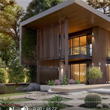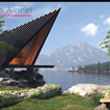سئلت كثيراً عن إعدادات الفي راي الجيدة.بالتأكيد أنه لا توجد إجابة عامة تصلح لجميع المشاهد بل تعتمد على ما تريد أنت من جودة و سرعة.لكن هذه مجموعة إعدادات وجدت انها تعمل جيداً في الصور الثابتة لأغلب الحالات.لاحظ أيضاً ان هذه الإعدادات ليست مثالية بالنظر إلى انها تحتاج بعض التغييرات منك لتحصل على سرعة أفضل بنفس الجودة.الشيء السار في هذه الإعدادات انها تضمن لك الحصول على نتائج جميلة في النهاية.

غير نوع الرندر إلى V-Ray renderer
:
(*) في صندوق حوار الرندر في جزءImage sampler rollout, غير إلى Adaptive QMC.
(*) حول Max. subdivs إلى 100 (one hundred). و اترك Min. subdivs ;كما هي على القيمة 1.
(*) غير primary GI engine إلى QMC GI. و لا تغير قيمة subdivs.
(*) غير secondary GI engine إلى Light cache.
(*) غير قيمة light cache interpolation samples إلى 5.
(*) غير QMC Sampler Adaptive amount إلى 1.0.
(*) ازل الإختيار من Clamp output في جزء Color mapping rollout.
(*) تحتاج إلى تغيير Noise threshold كالعادة تنتج تشويش كثير
لهذا أفضل قيمة لا تنتج تشويش هي 0.001.
(*) تمت العملية بنجاح.

لتتحكم في جودة الرندر مع الأخذ في الحسبان الزمن الناتج:
(*) تعديل QMC Noise threshold. إلى قيم قليلة يخفض التشويش و لكنه يزيد زمن الرندر
(*) تغيير قيمة light cache subdivs. تعتمد على نوع المشهد و لكن عموماً القيم من 1000 5000 تعطي نتائج جميلة و كما يمكنك ضبط الإعدادات الاخرى بنفسك
(*) إلغي إختيار reflective/refractive GI caustics إلا إذا كنت متاكد انك تحتاجها.
(*) و يمكن إختيار Use light cache for glossy rays حتى يسرع
glossy reflections.
(*) كما تحتاج لتعديل حجم render region (bucket) حسب الحجم الذي تريد حتى يعطيك معاينة سريعة لأجزاء المشهد.

ملاحظات:
(*) اترك جميع قيم subdivs في أي مكان كما هي لان تأثيرها غير محسوس
على أي حال قيمة 100 AA subdivs سوف تطغى على البقية
.
(*) لجميع الإصدارات قبل 1.49.30, لا تستخدم color mapping غير
Linear. و إلا ستفاجأ بنتائج غير صحيحة . , و إذا كنت تحتاج تعديل ضروري يمكنك عمل تصحيح ألوان بعد الرندر مثلاً في الفوتوشوب
. يجب أن تغير قيمة dark/bright
multipliers, و الأفضل ان تجعل لهما نفس القيمة.
(*) تجنب إستخدام sharpening AA filters. لأنه يجعل التشويش يبدو جلياً.
ميزة هذه الإعدادات:
(*) تعديلات قليلة بدون مجهود مع نتيجة جميلة في الرندر.
(*) تناسب حتى المشاهد الثقيلة.
(*) الجودة الناتجة عالية جداً.
عيوب هذه الإعدادات:
(*) بطيئة في الرندر و لكن يمكنك عمل تعديلات لزيادة السرعة.
كيف تعمل هذه الإعدادات:
القيمة العالية ل AA subdivs يجعل جميع عمليات السامبلنق Sampling تتم على سامبل الصور
image sampler. و سيأخذ قيم كثيرة من نفس النقطة عند الضرورة

مع خالص الإحترام:
Vlado
.......................
النص الأصلي
................................
Ive been asked many times what are good V-Ray settings. Of course, there is
no universal answer and it depends on the desired render speed and quality, but
here is a set of settings that I have found to work very well for still images
in many situations. Please note that these settings are not optimal, in the
sense that with enough tweaking, you can probably get similar quality with
faster render times. The beauty of these settings though, is that they require
almost no tweaking and you are guaranteed to get a nice result in the end.
Provided that you start with a default V-Ray renderer:
(*) In the Image sampler rollout, switch to Adaptive QMC.
(*) Set the Max. subdivs to 100 (one hundred). Leave the Min. subdivs to 1.
(*) Set the primary GI engine to QMC GI. Do not change the subdivs.
(*) Set the secondary GI engine to Light cache.
(*) Set the light cache interpolation samples to 5.
(*) Set the QMC Sampler Adaptive amount to 1.0.
(*) Un-check the Clamp output option in the Color mapping rollout.[*] Typically you will need to adjust the Noise threshold as the default
produces too much noise. A good value is 0.001.
(*) You are done.
To control render quality vs render time:
(*) Adjust the QMC Noise threshold. Lower values reduce noise, but increase
render times.
(*) Adjust the light cache subdivs. This is scene dependent, but usually values
from 1000 to 5000 are enough for most scenes. You can also adjust other light
cache parameters as necessary.
(*) Turn on or off reflective/refractive GI caustics as needed.
(*) Optionally turn on the Use light cache for glossy rays option to speed up
glossy reflections.
(*) You may want to adjust the render region (bucket) size for faster feed-back.
Notes:
(*) Leave all subdivs anywhere at their default values. They wont have any
effect anyways - the 100 AA subdivs will almost certainly override everything
else.
(*) For builds of V-Ray before 1.49.30, DO NOT use color mapping other than
Linear. Otherwise, you risk to get an incorrect result in the end. If
necessary, apply color correction in post. You can change the dark/bright
multipliers, provided that you leave both at the same value.
(*) Avoid using sharpening AA filters. They can make the noise more apparent.
Advantages of these settings:
(*) Very little parameters for controlling render quality.
(*) Work for a very large number of scenes.
(*) Typically produce high-quality results.
Disadvantages of these settings:
(*) May be slow to render. With tweaking, you may get faster results.
How it works:
The high AA subdivs essentially causes all the sampling to be performed by the
image sampler. It will take as many samples per pixel as required to achieve
the specified noise threshold. In many ways, this is similar to PPT, but is
done on a per-bucket basis and the number of samples is adaptive.
Best regards,
Vlado
أخوكم/ نجيب الفاتح





















اخي الكريم لو تحمل ملف الاعدادات با ندعي لك بالتوفيق
199
وجزاك عنا خيرا
لك تحياتي